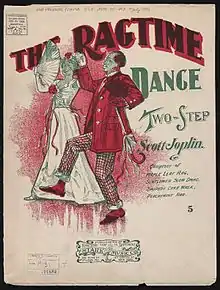The Ragtime Dance
"The Ragtime Dance" is a piece of ragtime music by Scott Joplin, first published in 1902.
| The Ragtime Dance | |
|---|---|
| by Scott Joplin | |
 Cover art for the 1906 sheet music | |
| Genre | Ragtime Folk Ballet |
| Form | A Stop-Time Two Step |
| Published | 1902 & 1906 |
| Publisher | John Stark & Son |
| Instrument: Piano Solo | |
Publication history
Although the piece was performed in Sedalia, Missouri on November 24, 1899, it wasn't published until 1902. John Stillwell Stark had planned publishing it in September 1899,[1] but had doubts about the marketability of the piece and delayed publication. When he eventually published it in 1902, at the urging of his daughter, it was a commercial failure.[2]
The 1902 arrangement was a short ragtime folk ballet suitable for stage performance, complete with narration and choreography. The narrator recounts a "dark town" ball that took place at 9 p.m. on a Thursday night and included a cakewalk. The choreography is for four couples.
Four years later, Stark republished the piece in a piano rag arrangement, stripped of its narration and choreography and substantially shortened.[2] The copyright for this arrangement was registered December 21, 1906.[3] The cover art for the 1906 sheet music featured an African American couple dancing in formal attire: the lady holds a fan, and the gentleman holds a top hat and cane.
Marvin Hamlisch incorporated "The Ragtime Dance" into a medley for the soundtrack of the Oscar-winning 1973 film The Sting.[4] The song also appeared in the soundtrack of the 1978 film Pretty Baby[5] and the 1980 Broadway musical revue Tintypes.[6]
Music (1906 arrangement)
The overall structure is: Intro AA BB CC D E F.[3]
It opens in the key of B-flat major, but modulates to E-flat major at the start of the "B" section.
The piece was subtitled "A Stop-Time Two Step". "Stop-time" refers to an unusual effect used in the second half of the piece. Starting with the "D" section, the pianist is instructed to "Stamp the heel of one foot heavily upon the floor" in time with the beat. Joplin reused this effect in his 1910 "Stoptime Rag".
Reception and legacy
In November 1970, Joshua Rifkin released a recording called Scott Joplin: Piano Rags[7] on the classical label Nonesuch, which featured as its third track "The Ragtime Dance". It sold 100,000 copies in its first year and eventually became Nonesuch's first million-selling record.[8] The Billboard "Best-Selling Classical LPs" chart for 28 September 1974 has the record at #5, with the follow-up "Volume 2" at #4, and a combined set of both volumes at #3. Separately both volumes had been on the chart for 64 weeks.[9] The album was nominated in 1971 for two Grammy Award categories: Best Album Notes and Best Instrumental Soloist Performance (without orchestra), but at the ceremony on March 14, 1972, Rifkin did not win in any category.[10] In 1979 Alan Rich in the New York Magazine wrote that by giving artists like Rifkin the opportunity to put Joplin's music on record Nonesuch Records "created, almost alone, the Scott Joplin revival."[11]
See also
References
- Edward A. Berlin. "A Biography of Scott Joplin". Archived from the original on February 24, 2007. Retrieved June 16, 2009.
- "Perfessor" Bill Edwards. "Rags and Pieces by Scott Joplin". Archived from the original on February 2, 2013. Retrieved June 16, 2009.
- Jasen, David A.; Trebor Jay Tichenor (1978). Rags and Ragtime: A Musical History. New York, NY: Dover Publications, Inc. p. 93. ISBN 0-486-25922-6.
- "Mfiles: The Sting". Retrieved June 16, 2009.
- "Soundtrack Collector: Pretty Baby". Retrieved June 16, 2009.
- "IBDB song list: Tintypes". Retrieved June 16, 2009.
- "Scott Joplin Piano Rags Nonesuch Records CD (w/bonus tracks)". Retrieved March 19, 2009.
- "Nonesuch Records". Retrieved March 19, 2009.
- Billboard magazine 1974, p. 61.
- LA Times.
- Rich 1979.
Sources
- LA Times. "Entertainment Awards Database". Los Angeles Times. Retrieved March 17, 2009.CS1 maint: ref=harv (link)
- Billboard magazine (1974). "Best Selling Classical LPs". Billboard Magazine (28th September 1974): 61. Retrieved July 29, 2011.CS1 maint: ref=harv (link)
- Rich, Alan (1979). "Music". New York Magazine. New York Media LLC (24th December 1979): 81. Retrieved August 5, 2011.CS1 maint: ref=harv (link)
External links
| Wikimedia Commons has media related to Scott Joplin Ragtime Dance (1902). |